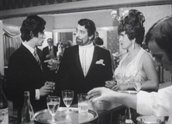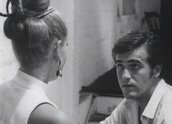


The Set (1969)
Synopsis
A young working-class man who sells shirts at a Sydney department store, Paul Lawrence (Sean McEuan), dreams of going to art school. When his girlfriend Cara (Julie Rogers) leaves for London, Paul becomes the protégé of renowned designer Marie Rosefield (Brenda Sender). Marie belongs to ‘the set’, an upper-class clique whose members include Mark Bronoski (Denis Doonan), an influential artist. Bronoski commissions Paul to design a set for flamboyant British stage director John L Fredericks (Michael Charnley). Helping Paul is Tony Brown (Rod Mullinar), a handsome student who is dating Paul’s cousin, Kim Sylvester (Bronwyn Barber). As Paul becomes part of ‘the set’, he begins a homosexual relationship with Tony. Meanwhile, Kim’s mother, Peggy (Hazel Phillips), is bored with her marriage and has an affair with Bronoski. As the deadline for the set approaches, Paul starts to question his values and those of his new friends.
Curator’s notes
The 1960s was the ‘silent’ decade of Australian cinema. Even with the inclusion of foreign-financed entries such as The Sundowners (1960) and Blazing Continent (Moeru Tairiku, 1968), less than 20 features were shot down under between 1960 and 1969.
The first Australian feature with homosexuality as a central theme, The Set was based on a manuscript by actor Roger Ward (Stone, 1974; Mad Max, 1979). At the suggestion of fellow actor Ed Deveraux, Ward contacted Frank Brittain, an American who’d produced the outback drama Journey Out of Darkness (1967) and was looking for another project. Brittain asked Ward to trim the lengthy draft and create a screenplay centred on the story’s homosexual content.
The Set made newspaper headlines from the moment it started filming in early 1969. Commanding much more ink than the gay elements were updates of which Sydney houses had been used as locations and who was appearing in this supposedly salacious exposé of permissive society. The biggest controversy surrounded Hazel Phillips, a television star who’d been in The Mavis Bramston Show (1964–68) and Beauty and the Beast (1964–73), an afternoon panel show for housewives. Considerable hoopla also accompanied the casting of colourful society figure Elza Stenning as Mark’s mother, Baroness Bronoski. Previously known as Elsa Jacoby, Stenning’s only prior roles had been in The Devil’s Playground (1928) and Frank Thring Sr’s Harmony Row (1933). Her singing performance at Mark’s party is one of the more bizarre moments of The Set.
The dialogue is stiff and some of the acting even stiffer, but as a lively and incident-packed time capsule, The Set is of great interest. The sexually confused, artistically inclined ‘angry young man’ protagonist and almost everyone he meets is restless and stifled by some form of conservatism. Paul loves Cara, but his father disapproves because her family are migrants. Almost a decade before the first Gay Mardi Gras (1978) in Sydney made coming out less traumatic, Tony is filled with self loathing at his sexuality and attempts to cover-up by bedding a series of disappointed women. Peggy tells daughter Kim that being married to her father is ‘like dating a Franciscan monk’, and swoons when she meets smooth-talking artist Bronoski and anyone else with a vaguely bohemian air.
The symbolism of Paul designing a stage set while his life in ‘the set’ is slowly falling apart may be laboured, and the depiction of ‘swinging society’ looks rather tame, but the film has a redeeming sincerity. There is no doubt that its makers were earnestly attempting to comment on the state of things without ever looking down on the homosexuals and drag queens drifting in and out of the frame. It is worthy of being recognised as more than just ‘Australia’s first professional sexploitation movie’ – as described by critic Mike Thornhill in The Australian on 28 February 1970. That said, it has some marvellous kitsch elements including a Sven Libaek score that could just about pass as groovy mood music by a modern combo such as Air, and some of the most eye-catching party frocks and hairdos you’ll ever see in an Australian movie. Brenda Sender’s beehive-artichoke combo (see clip one) is the highlight coiffure in a competitive field.
A genuine Aussie curiosity, The Set has screened rarely since its cinema release on 4 February 1970 and has never been released commercially on VHS or DVD (as of June 2011).
- Overview
- Curator’s notes
- Video 3 clips
- Principal credits
- Find a copy
- Comments 1
- Map
- Add your review



